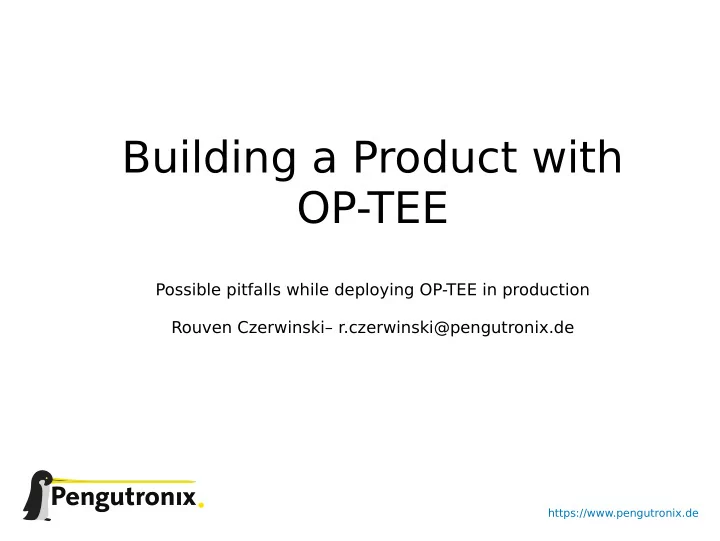

Building a Product with OP-TEE Possible pitfalls while deploying OP-TEE in production Rouven Czerwinski– r.czerwinski@pengutronix.de https://www.pengutronix.de
About me Rouven Czerwinski Pengutronix e.K. Emantor rcz@pengutronix.de OP-TEE System Integration T esting 2/21
T able of Contents Short overview: Introduction Motivation Problems Solutions Conclusion Outlook 3/21
TrustZone (32-bit) 4/21
Introduction Open Portable T rusted Execution Environment (OP-TEE) Open source (BSD-2 clause) implementation of the GP TEE specifjcation using T rustZone Support for various ARM platforms (STM32, TI, Layerscape, broadcom,…) My focus is on i.MX6 platforms 5/21
Motivation Secure the OP-TEE and TAs for production use Ensure that upstream OP-TEE can be used securely on i.MX6 Provide guidance which parts may be missing for other platforms (TI, STM, Layerscape,…) 6/21
Problem Which components do I need to secure OP-TEE? Which part of the confjguration is already upstream? Which part needs to be managed by system integrator? 7/21
Securing upstream OP-TEE RAM protection/Pager Hardware Unique Key (HUK) RNG Seeding Peripheral Access Confjguration Ensure trusted OP-TEE bootup Optional: storage rollback protection 8/21
RAM protection Confjgure the DDR fjrewall Protects part of RAM for secure world i.e. TZC380 with multiple regions For i.MX6: TZC380 from ARM Upstream driver already within OP-TEE 9/21
i.MX6 TZC380 autoconfjguration TZC380 auto confjguration upstream Correctly confjgures TZC380 for generic RAM devices with known memory layout 10/21
OP-TEE Pager Run small part of OP-TEE in SRAM Encrypt other memory pages live in DRAM Does not require a DDR fjrewall For i.MX6: Chosen i.MX6UL may not have enough SRAM Bigger variants may use SRAM for other use cases (IPU, GPU,…) 11/21
Hardware Unique Key (HUK) Used to derive other keys for OP-TEE Should be unique per device Should not be accessible from normal world For i.MX6: Use CAAM Master Key Verifjcation Blob (MKVB) and lockout generation afterwards 12/21
i.MX6 HUK generation Needs rebase on i.MX6/7 CAAM driver Will be done soon™ 13/21
RNG seeding OP-TEE uses FORTUNA PRNG Requires RNG seed Default seed for dev is zero For i.MX6: Retrieve RNG from CAAM TRNG on bootup Not implemented yet 14/21
Peripheral Access Confjguration SoCs have DMA masters beside CPU Those masters may be default secure and can access secure world memory For i.MX6: Access policies confjgurable via Central Security Unit (CSU) 15/21
i.MX6 CSU Upstream confjgures correctly for i.MX6UL Other i.MX6/7 SoCs trivial to add (given Security Reference Manual) 16/21
Trusted Bootup Use platform verifjed/secure boot Verifjes OP-TEE version to prevent replacements For i.MX6: Implement High Assurance Boot (HAB), also required for HUK Not implementable upstream, needs to be handled by integrator 17/21
Storage Rollback protection T o protect from rollback attacks, employ eMMC RPMB FS Simple FAT fjlesystem For all platforms: Enable with CFG_RPMB_FS=1 Deploy during manufacturing with CFG_RPMB_WRITE_KEY=1 Ensure to disable emulation in TEE Supplicant with RPMB_EMU=0 Support upstream 18/21
Conclusion No platform is currently ready to deploy OP-TEE in production i.MX6 is slowly getting there Vendor implementations may include the necessary bits Still requires code review and cross reference to platform manual 19/21
Outlook (Wishlist) Clock and access coordination between OP-TEE and Linux Deeper device tree integration for OP-TEE CI infrastructure to test each commit to OP-TEE master for i.MX6/7 20/21
Thank you Questions? https://www.pengutronix.de
Recommend
More recommend